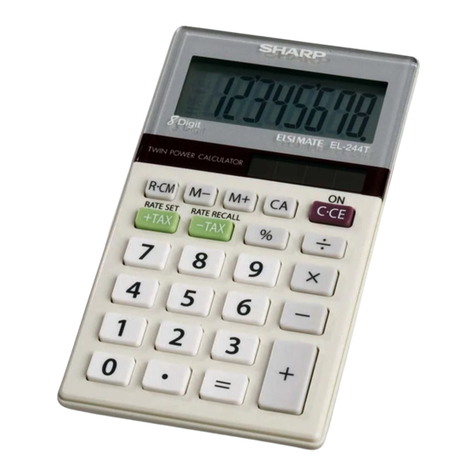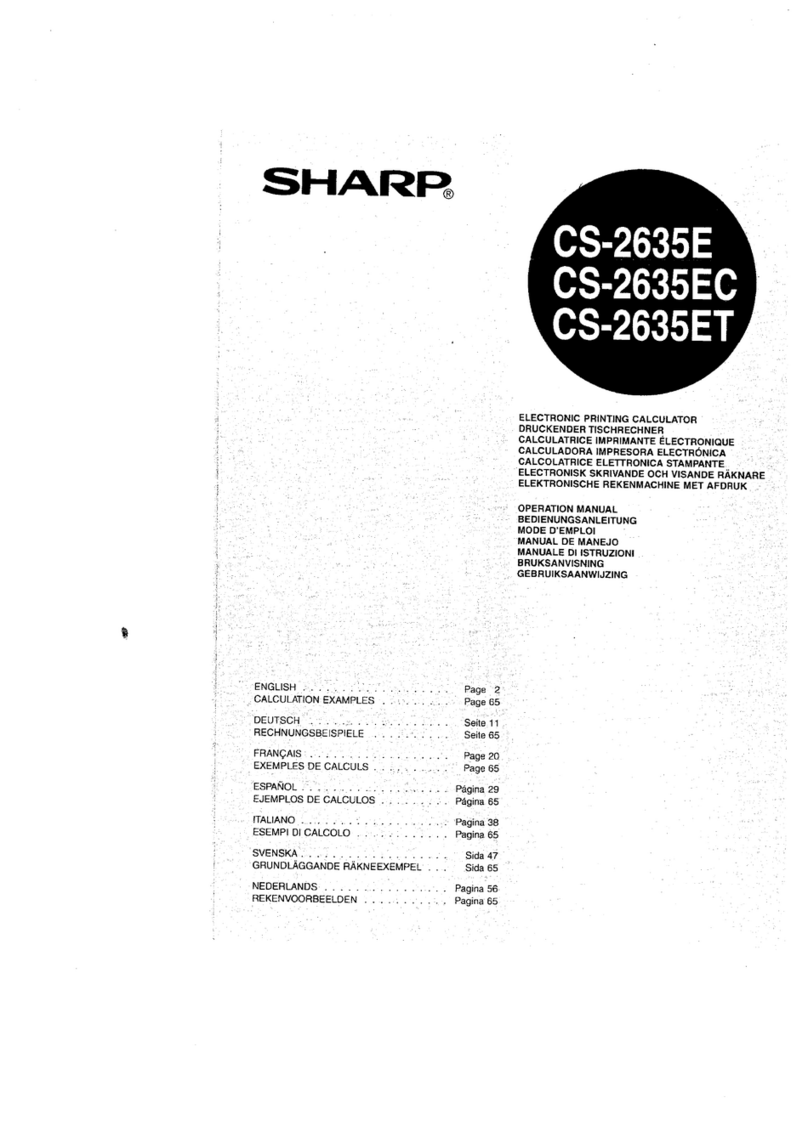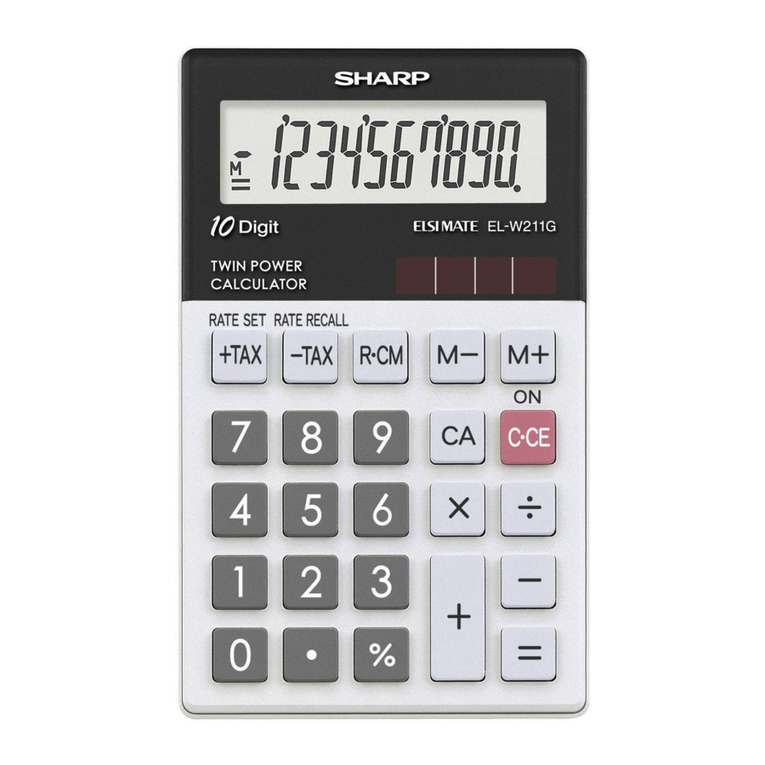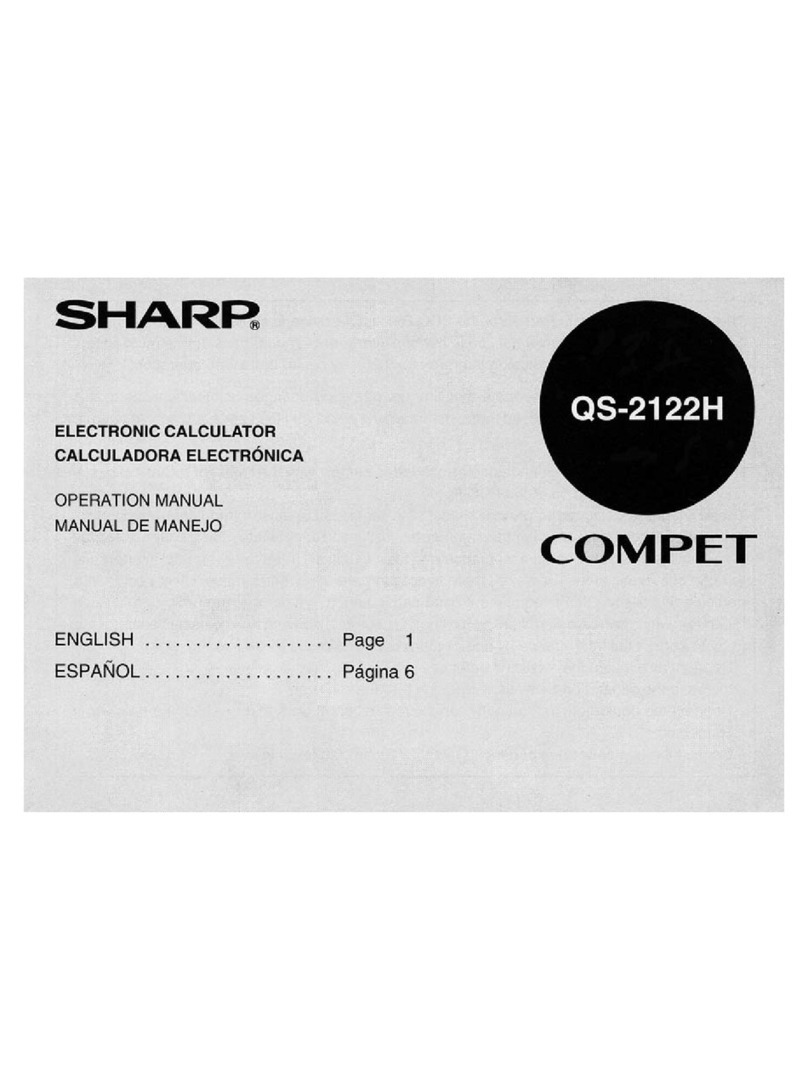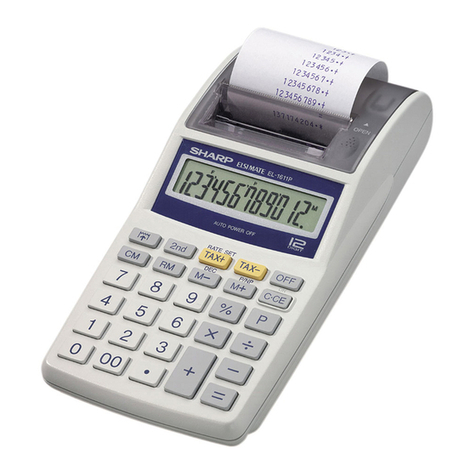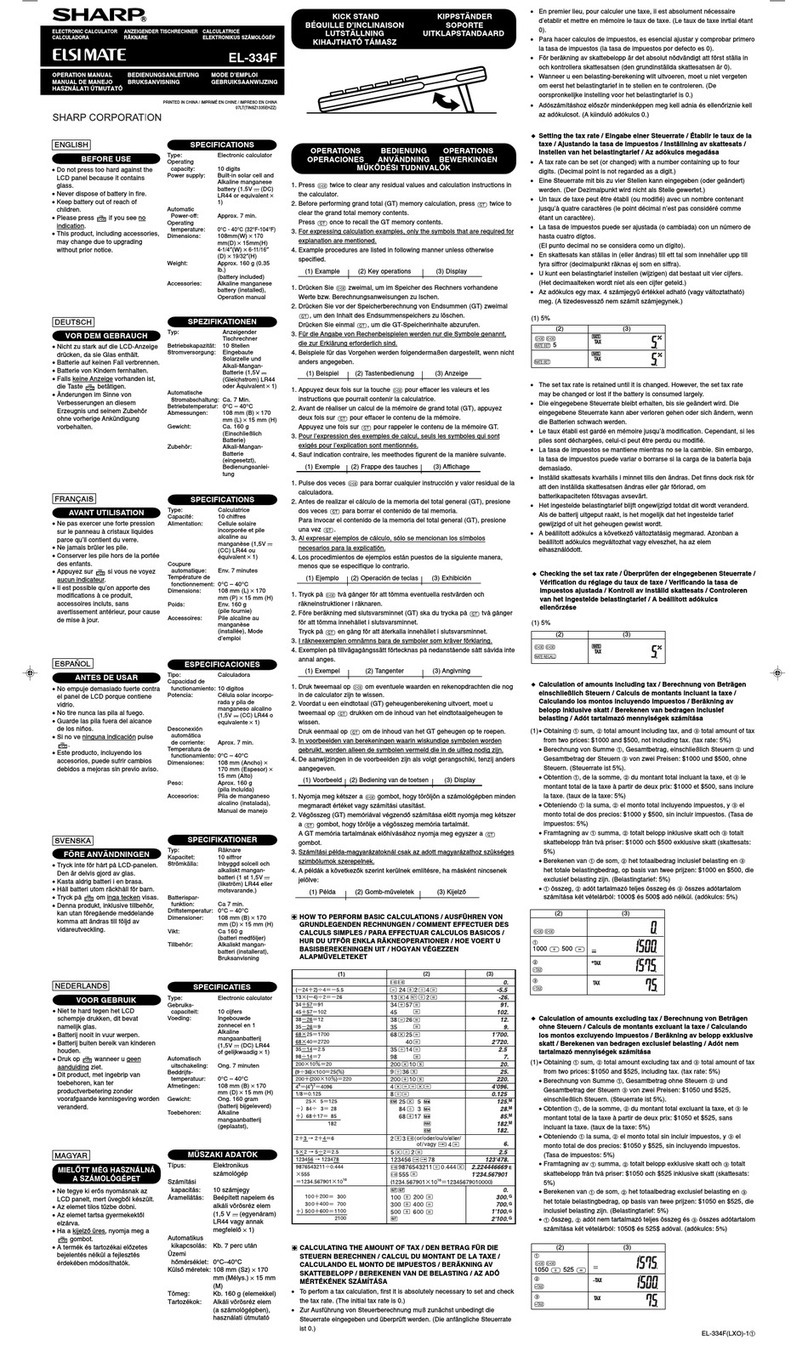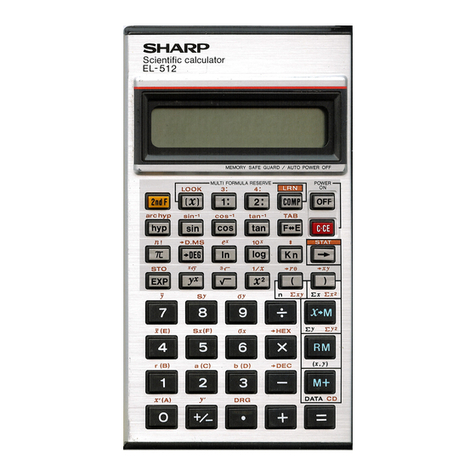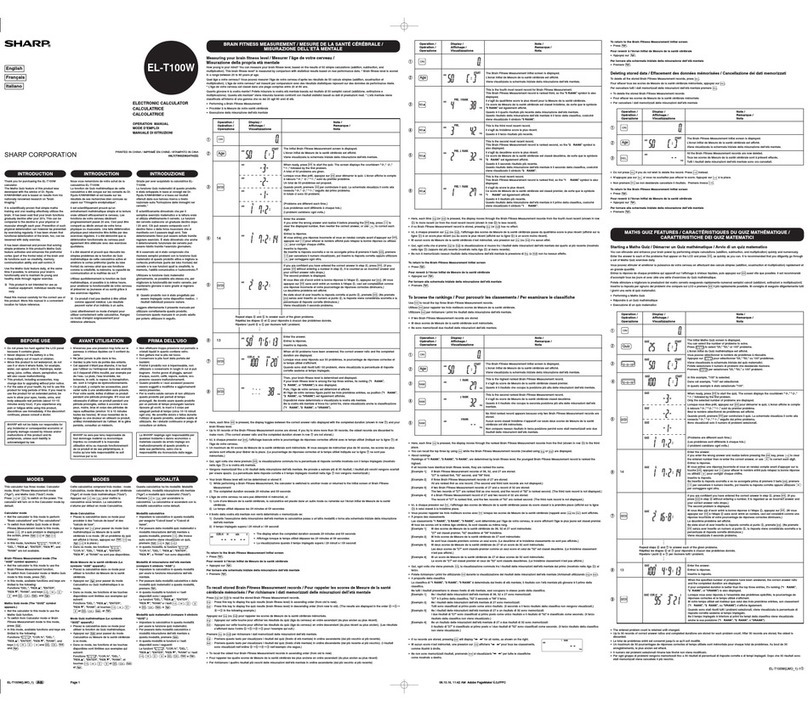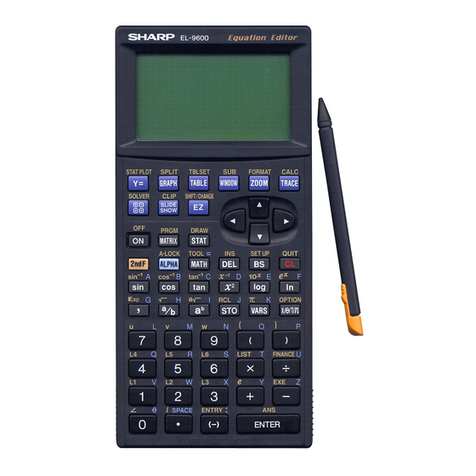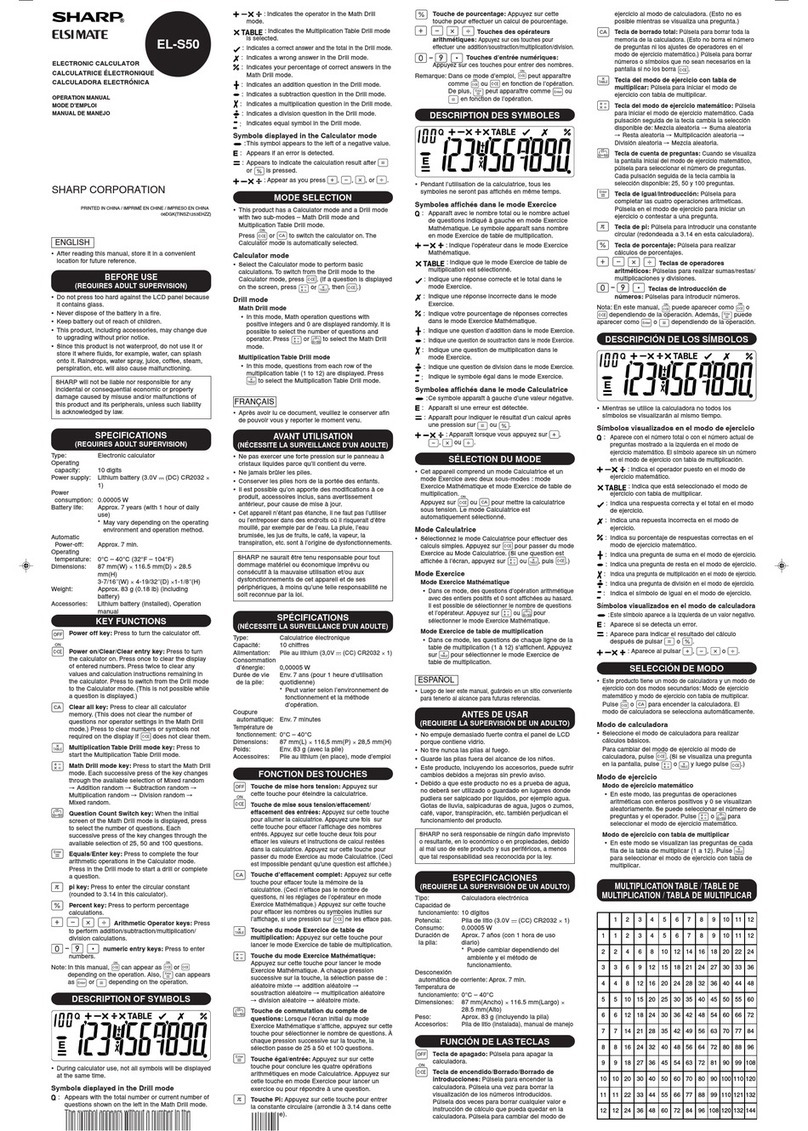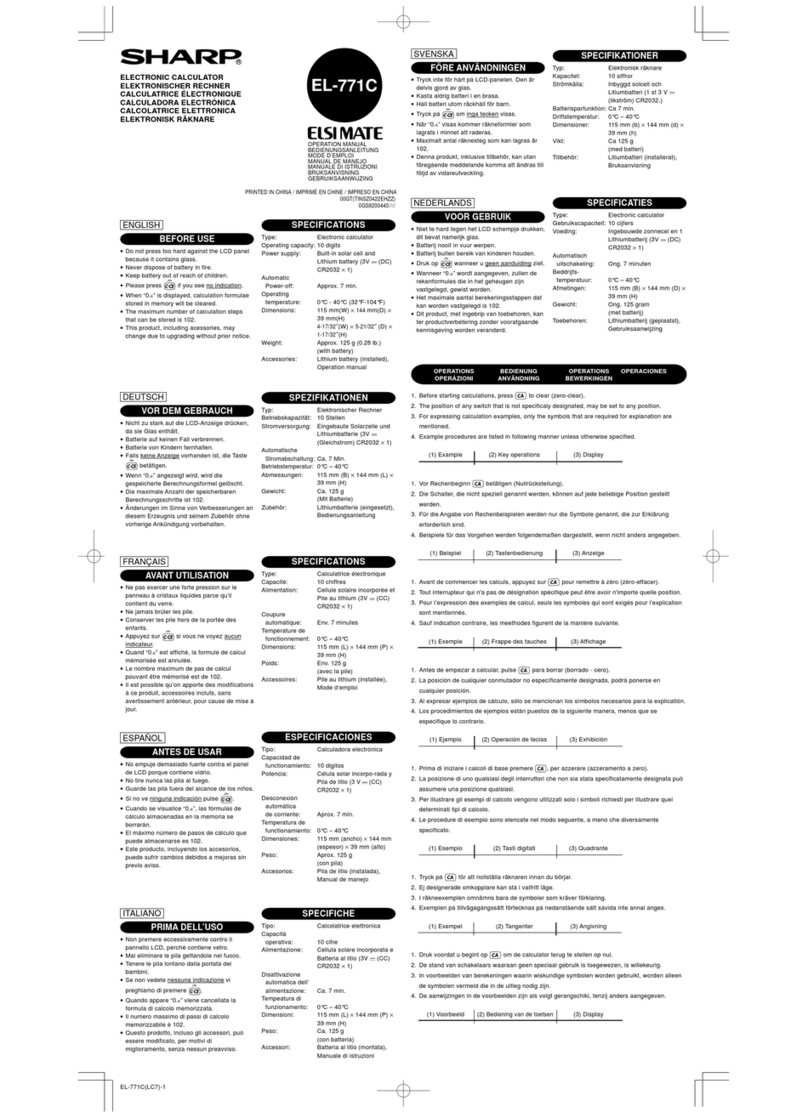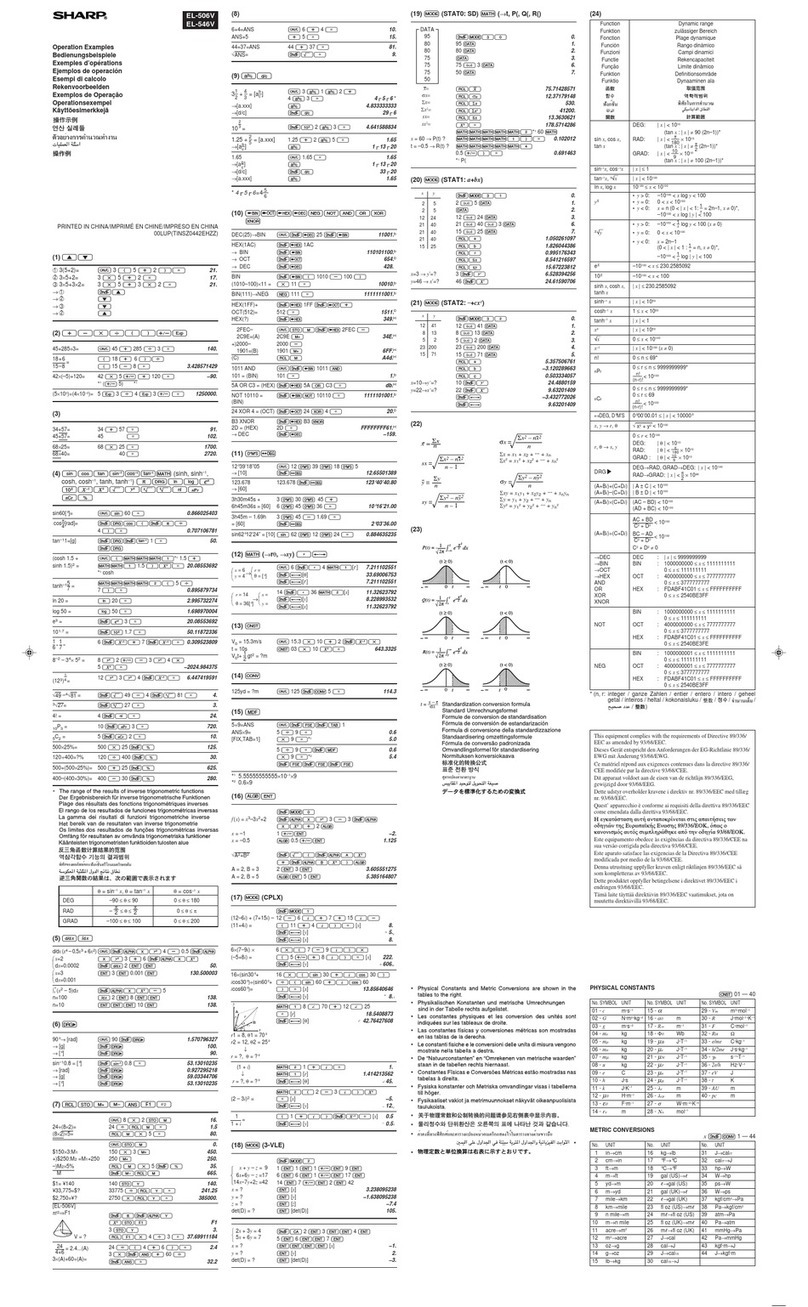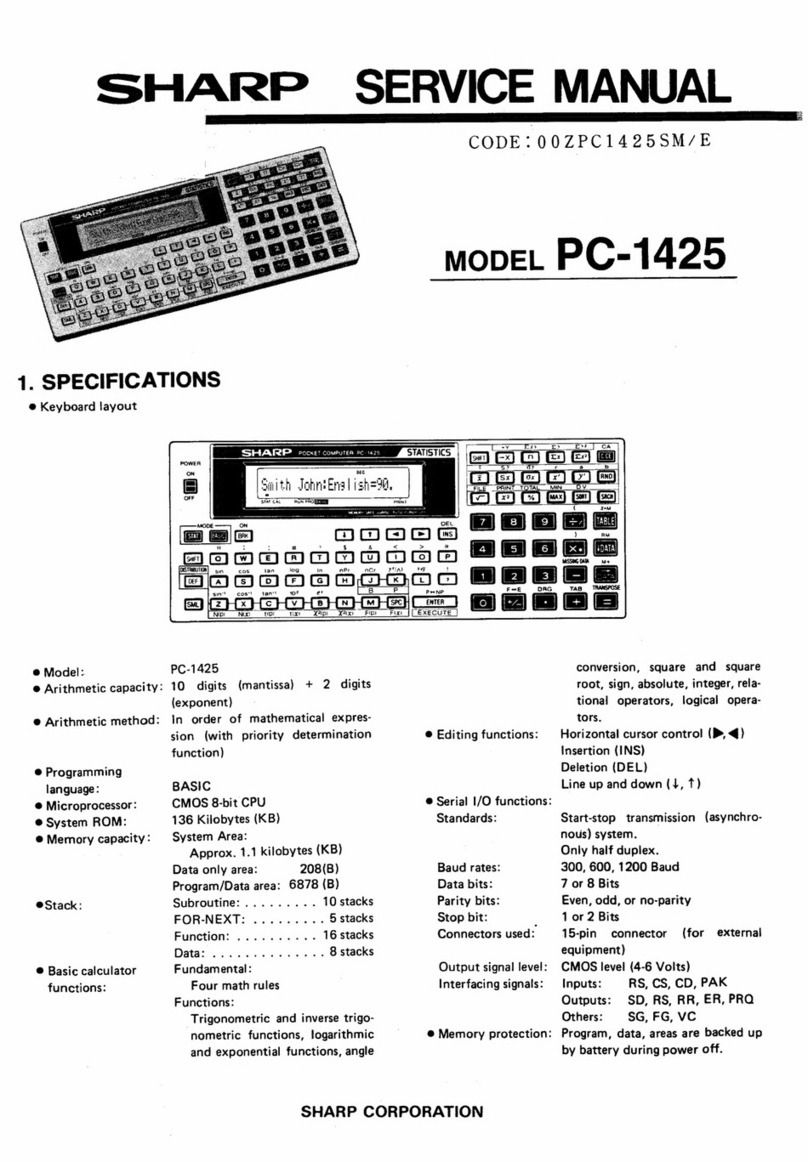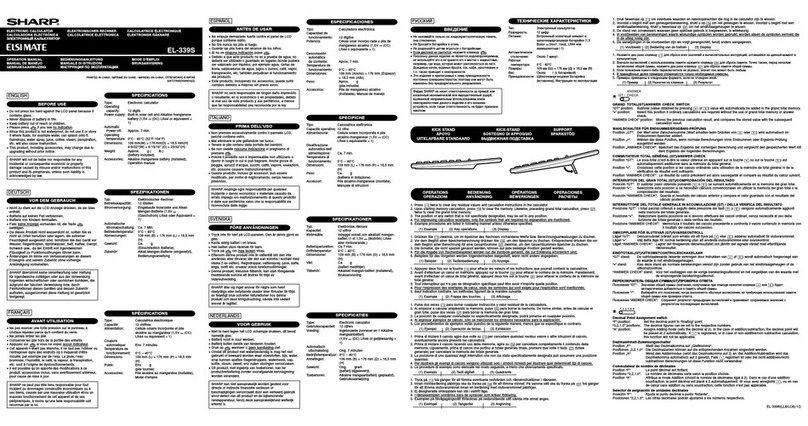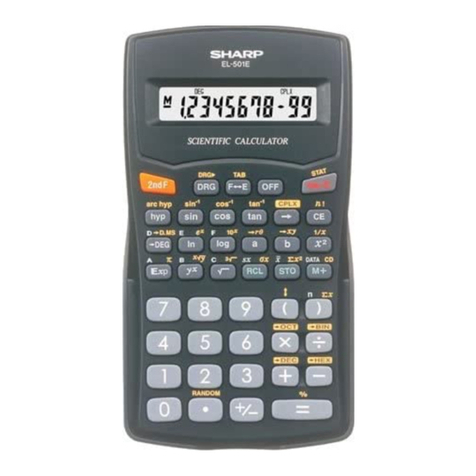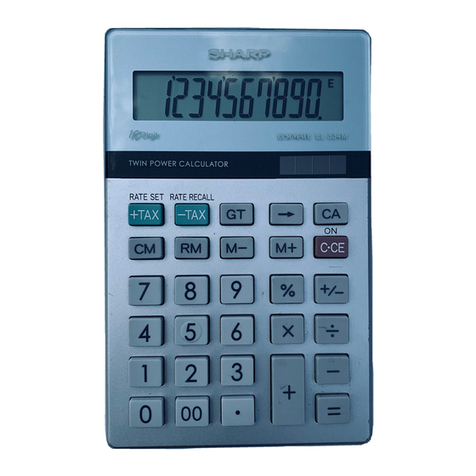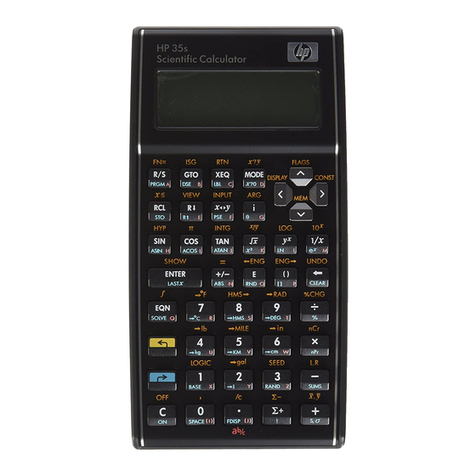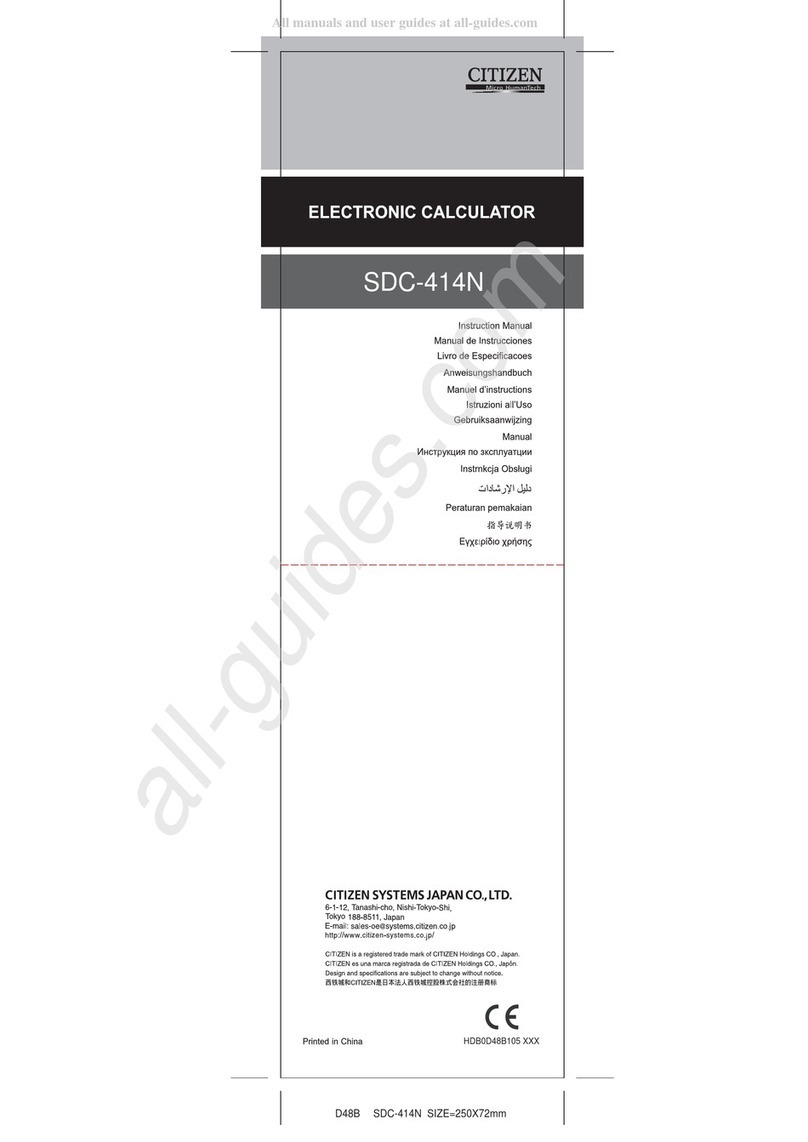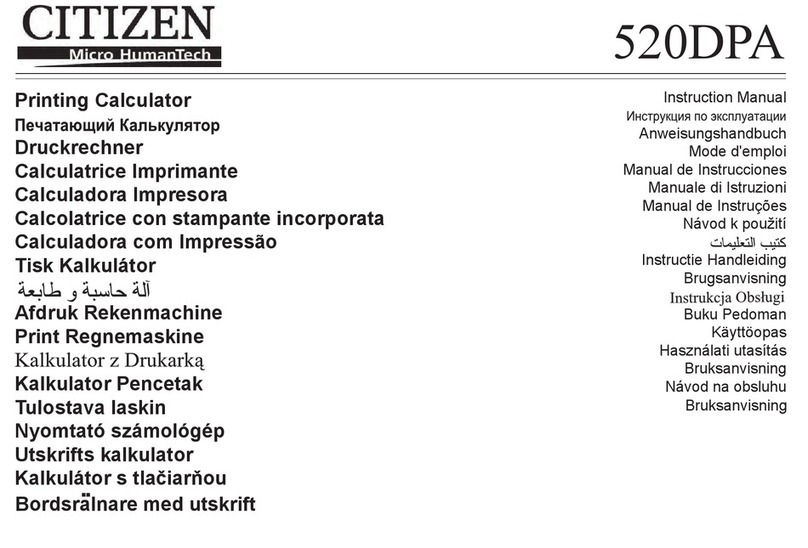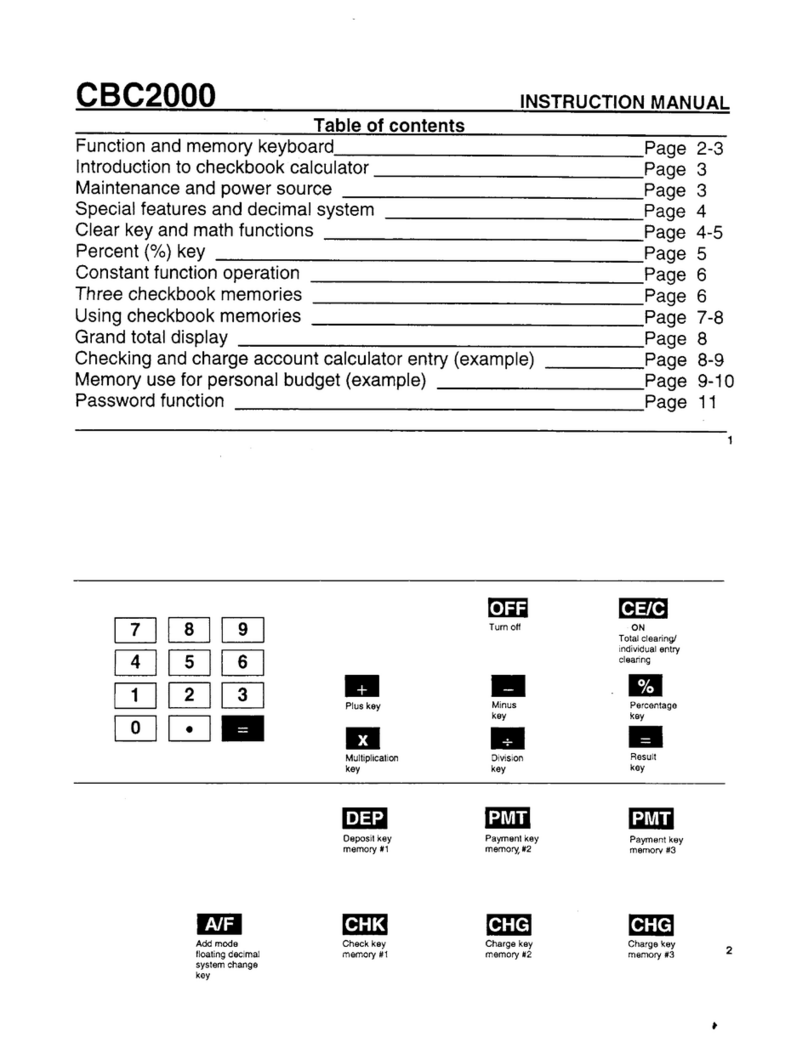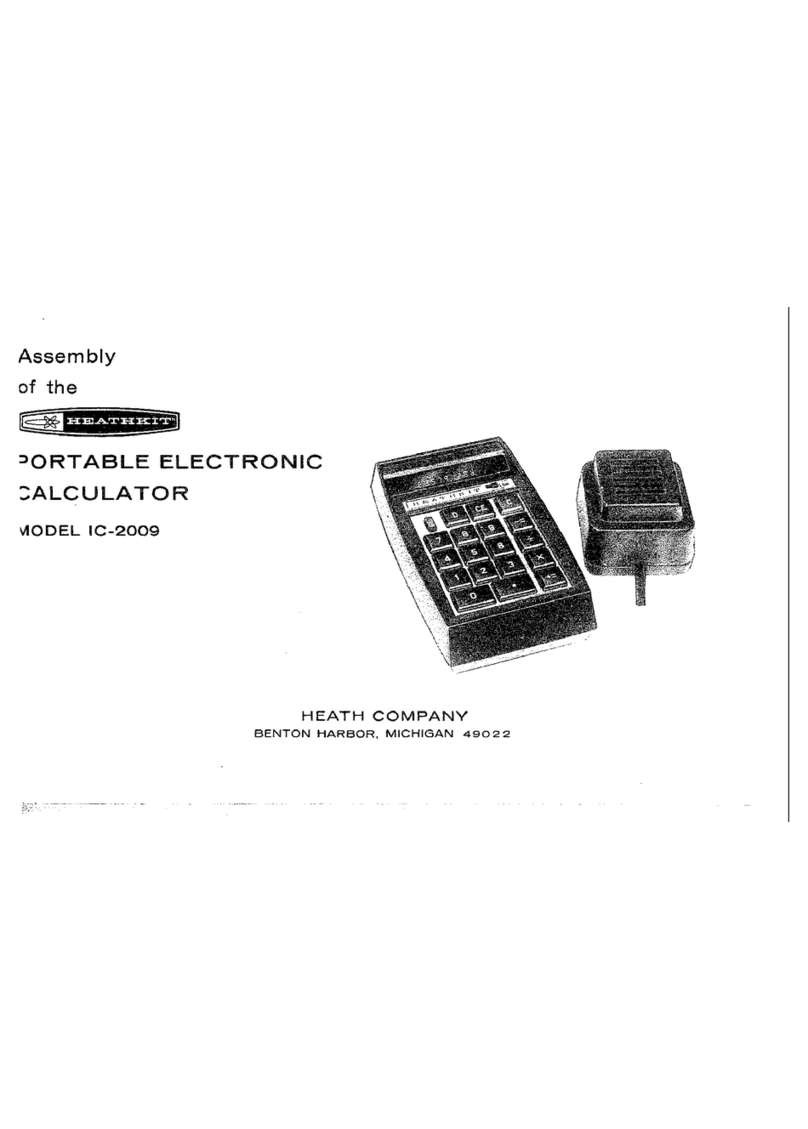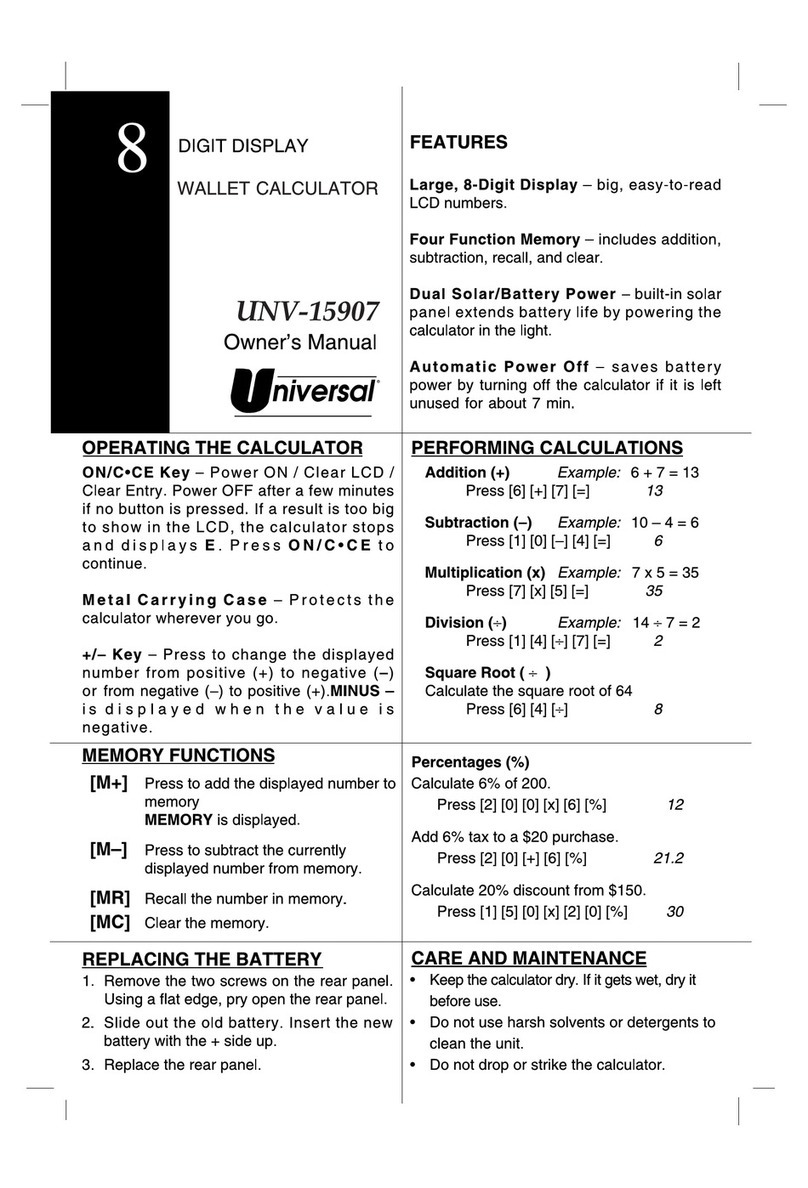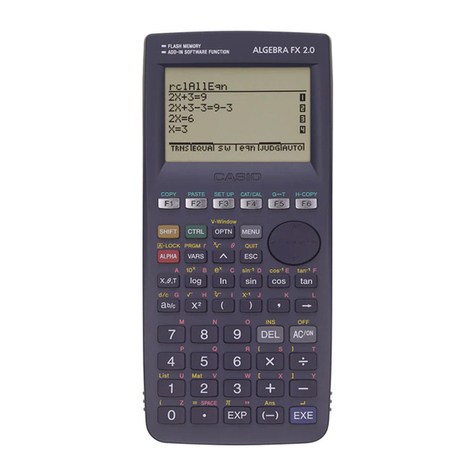
N3 \1 \2 +
4 \3 =
4
l
5
l
6
*
→[a.xxx] \
4.833333333
→[d/c] @|
29
l
6
@¡ 2 \3 =
4.641588834
1.25 +2 \5 =
1.65
\
1
l
13
l
20
Random Numbers
A pseudo-random number with three significant digits can be gen-
erated by pressing @`=.
To generate the next random number, press =.
This function can be performed in the normal and statistics modes.
(This function is not supported under the N-Base function.)
•Random numbers use memory Y. Each random number is gen-
erated on the basis of the value stored in memory Y (pseudo-
random number series).
•To generate a new series of pseudo-random numbers, press
NOYto clear the memory Y.
Angular Unit Conversions
90°→[rad] N90 @g
1.570796327
→[g] @g
100.
→[°] @g
90.
sin–10.8 = [°] @S 0.8 =
53.13010235
→[rad] @g
0.927295218
→[g] @g
59.03344706
→[°] @g
53.13010235
Memory Calculations
The calculator has six temporary memories (A-D, X and Y), one
independent memory (M) and one last answer memory (ANS).
Mode ANS M A-D, X,Y
Normal
Complex ×
3-VLE ×××
Statistic ××
: Available ×: Unavailable
Priority Levels in Calculation
This calculator performs operations according to the following pri-
ority:
Q∠
WFunctions preceded by their argument (x-1, x2, n!, etc.)
EYx, x¿
RImplied multiplication of a memory value (2Y, etc.)
TFunctions followed by their argument (sin, cos, etc.)
YImplied multiplication of a function (2sin30, etc.)
UnCr, nPr
I×, ÷
O+, –
PAND
{OR, XOR, XNOR
}=, M+, M–, ⇒M, |DEG, |RAD, |GRAD, DATA, CD, →rθ, →xy
and other calculation ending instruction
•If parentheses are used, parenthesized calculations have prec-
edence over any other calculations.
INITIAL SETUP
Mode Selection
Normal mode: m0
Used to perform arithmetic operations and function calculations.
The pointer “Æ” appears below “0: NORMAL”.
Complex number mode: m1
Used to perform arithmetic operations with complex numbers.
The pointer “Æ” appears below “1: CPLX”.
3-VLE mode : m2
Used to perform simultaneous linear equations with three unknowns.
The pointer “Æ” appears below “2: 3-VLE”.
Statistic mode: m3
Used to perform statistical calculations.
The pointer “Æ” appears below “3: STAT”.
When executing mode selection, temporary memories, statistical
data and last answer memory will be cleared even when reselecting
the same mode.
BEFORE USING THE CALCULATOR
Key Notation Used in this Manual
In this manual, key operations are described as follows:
To specify ex:@e
To specify E (HEX) : E
To specify ln : I
To specify X : @KX
To access functions printed in orange above the key, press @
first.
Numbers are not shown as keys, but as ordinary numbers.
Power On and Off
Press Nto turn the calculator on, and @Fto turn it off.
Clearing Methods
There are three clearing methods as follows:
Clearing Entry M*1A-D, X,Y*2
operation (Display) STAT, ANS
N××
@c ×
RESET
: Clear ×: Retain
*1Independent memory M.
*2Temporary memories A-D, X and Y, statistical data, and last an-
swer memory.
Refer to the Memory Calculations section.
Editing the Equation
•Press <or >to move the cursor.
To return to the equation after getting an answer, press @
'.
•To delete a number, move the cursor to the number to be
deleted, then press d.
The number under the cursor will be deleted.
•To insert a number, move the cursor to the place immediately
after where the number is to be inserted, then enter the number.
DISPLAY
Symbol
Equation
Display
Mantissa Exponent
(All symbols will not be displayed simultaneously, as shown above.)
:Appears when the entire equation cannot be displayed.
Press </>to see the remaining (hidden) section.
xy/r
θ
:Indicates the mode of expression of results in the com-
plex calculation mode.
2ndF : Appears when @is pressed, indicating that the func-
tions shown in orange are enabled.
HYP : Indicates that hhas been pressed, and the hyper-
bolic functions are enabled. If @H are pressed,
the symbols “2ndF HYP” should appear, indicating that
inverse hyperbolic functions are enabled.
ALPHA : Indicates that @Kor O(R) has been
pressed, and entry (recalling) of memory contents and
recalling of statistics can be performed.
FIX/SCI/ENG: Indicates the notation used to display a value and
changes each time @fare pressed.
DEG/RAD/GRAD: Indicates angular units and changes each time
Gis pressed.
:Appears when a simulation calculation is executed.
M:Indicates that a numerical value is stored in the inde-
pendent memory.
Æ:Indicates the operation mode.
?:Indicates that the calculator waits for a numerical value
entry, such as during simulation calculation.
:Appears when the calculator shows an angle as the
result in the complex calculation mode.
i:Indicates an imaginary number is being displayed in the
complex calculation mode.
ALGB
Selecting the Display Notation and Decimal Places
The calculator has four display notation systems for displaying
calculation results. When FIX, SCI, or ENG symbol is displayed,
the number of decimal places can be set to any value between 0
and 9. Displayed values will be reduced to the corresponding
number of digits.
100000÷3=
[Floating point] N100000/3=33333.33333
→[FIXed decimal point] @f 33333.33333
[TAB set to 2] @i 2 33333.33
→[SCIentific notation] @f 3.33×104
→[ENGineering notation] @f 33.33×103
→[Floating point] @f 33333.33333
•If the value for floating point system does not fit in the following
range, the calculator will display the result using scientific notation
system:
0.000000001 ≤| x| ≤9999999999
Determination of the Angular Unit
In this calculator, the following three angular units can be speci-
fied.
(Radians)
Press G
SCIENTIFIC CALCULATIONS
•Press m0to select the normal mode.
•In each example, press Nto clear the display.
•If the FIX, SCI, or ENG indicator is displayed, clear the indicator
by pressing @f.
Arithmetic Operations
45+285÷3= N45 +285 /3 =
140.
18+6 =(18 +6 )/
15–8 (15 -8 =*1
3.428571429
42×(–5)+120= 42 *5 ±+120 =
–90.
*2(±5) *2
(5×103)÷(4×10–3)= 5 E3 /4 E3 ±=
1250000.
*1The closing parenthesis )just before =or ;may be
omitted.
π
2π
2
1
7
1
6
5
7
1
4
Functions
•Before starting calculations, specify the angular unit.
sin60[°]= Ns 60 =
0.866025403
cos–[rad]= Gu(@V/
4 )=
0.707106781
tan–11=[g] G@T 1 =
50.
G
•The results of inverse trigonometric functions are displayed within
the following range:
θ= sin–1 x
,
θ= tan–1 xθ= cos–1 x
DEG –90 ≤θ≤90 0 ≤θ≤180
RAD – —≤θ≤—0 ≤θ≤π
GRAD –100 ≤θ≤100 0 ≤θ≤200
π
4
(cosh 1.5 + N(hu 1.5 +
sinh 1.5)2= hs 1.5 )L=
20.08553692
@Ht( 5 /
tanh–1– = 7 )=
0.895879734
ln 20 = I20 =
2.995732274
log 50 = l50 =
1.698970004
e3= @e 3 =
20.08553692
101.7 = @¡ 1.7 =
50.11872336
– + – = 6 @•+ 7 @•=
0.309523809
8–2 – 34×52=8™2 ±-3 ™4 *
5 L=
–2024.984375
(123)–=12 ™3 ™4 @•=
6.447419591
√49 –4√81 = ⁄49 -4 @$ 81 =
4.
3√27 = @# 27 =
3.
4! = 4 @!=
24.
10P3= 10 @q 3 =
720.
•
DEC(25)→BIN N@í 25 @ê
11001.
b
HEX(1AC) @ì 1AC
1AC.
H
→BIN @ê
110101100.
b
→OCT @î
654.
0
→DEC @í
428.
BIN @ê( 1010 -100 )
(1010–100)×11 = *11 =
10010.
b
BIN(111)→NEG ã111 =
1111111001.
b
5C2=5@Q 2 =
10.
500×25%= 500 *25 %
125.
120÷400=?% 120 /400 %
30.
500+(500×25%)= 500 +25 %
625.
400–(400×30%)= 400 -30 %
280.
24 = 2.4...(A) 24 /( 4 +6 )=
2.4
4+6 3 *@?+ 60 /
3×(A)+60÷(A)= @?=
32.2
*Entry of the multiplication procedure is omitted between "π" and
a variable.
1
2
b
c
4
3
3– + – = [a–]
HEX(1FF)+ @ì 1FF @î+ 512 =
1511.
0
OCT(512)= @ì
349.
H
HEX(?)
2FEC– NOM@ì 2FEC
2C9E=(A) -2C9E ;
34E.
H
+)2000– 2000 -
1901=(B) 1901 ;
6FF.
H
(C) RM
A4d.
H
1011 AND N@ê 1011 †
101 = (BIN) 101 =
1.
b
5A OR C3 = (HEX) @ì 5A äC3 =
db.
H
NOT 10110 = @êâ 10110 =
1111101001.
b
(BIN)
24 XOR 4 = (OCT) @î 24 à4 =
20.
0
B3 XNOR @ì B3 á
2D = (HEX) 2D =
FFFFFFFF61.
H
→ DEC @í
–159.
Time, Decimal and Sexagesimal Calculations
Conversion between decimal and sexagesimal numbers can be
performed. In addition, the four basic arithmetic operations and
memory calculations can be carried out using the sexagesimal
system.
12°39’18”05 N12 o39 o18 o5
→[10] @_
12.65501389
123.678 123.678 @_
123°40’40.80
→[60]
3h30m45s + 3 o30 o45 +6 o
6h45m36s = [60] 45 o36 =
10°16’21.00
3h45m – 1.69h = 3 o45 -1.69 =
[60] @_
2°03’36.00
sin62°12’24” = [10] s62 o12 o24 =
0.884635235
Chain Calculations
While performing the four basic arithmetic operations, the result
can be used in the subsequent arithmetic operation.
6+4=ANS N6 +4 =
10.
ANS+5 +5 =
15.
The previous calculation result will not be recalled after entering
multiple instructions.
Fraction Calculations
\: Used to enter a fraction or to convert numbers.
@|:Used to convert numbers.
•Adecimal number, variable, or exponent cannot be entered as a
fraction.
•In all cases, a total of up to 10 digits including integer, numera-
tor, denominator and the symbol (l) can be entered.
•
If the number of digits to be displayed is greater than 10, the
number is converted to and displayed as a decimal number.
P (x,y)
X
Y
0
y
x
P (r,
θ
)
X
Y
0
r
θ
Polar coord.
Coordinate Conversions
•Before performing a calculation, select the angular unit.
Rectangular coord.
m0
f(x) = x3–3x2+2 @KX™ 3 -3 @K
XL+ 2 @≤
x= –1 1 ±®
–2.
x= –0.5 @≤ 0.5 ±®
1.125
√
A2+B2⁄(@KAL
+@KBL)@≤
A = 2, B = 3 2 ®3 ®
3.605551275
A = 2, B = 5 @≤® 5 ®
5.385164807
SIMULATION CALCULATION
To obtain a result consecutively using the same formula, such as
plotting a curve line for 2x2+ 1, or finding the variable for 2x+ 2y
=14, simply specify a new value for each variable in the formula.
Usable variables: A-D, M, X and Y
Unusable functions: RANDOM
•Simulation calculations can only be executed in the normal mode.
•Calculation ending instructions (%, etc.) other than =cannot
be used.
Performing Calculations
QPress m0.
WEnter a formula with at least one variable.
EPress @≤.
RVariable input screen will appear. Enter the value of the flashing
variable, then press ®to confirm. The calculation result will
be displayed after entering the value for all used variables.
•Only numerical values are allowed as variables. Entry of
formulas are not permitted.
•Upon completing the calculation, press @≤ to perform
calculations using the same formula.
•Variables and numerical values stored in the memories will be
displayed in the variable input screen. To change a numerical
value, enter the new value and press ®.
Modify Function
In this calculator, all calculation results are internally obtained in
scientific notation with up to 12 digits for the mantissa.
However, since calculation results are displayed in the form desig-
nated by the display notation and the number of decimal places
indicated, the internal calculation result may differ from that shown
in the display.
By using the modify function, the internal value is converted to
match that of the display, so that the displayed value can be used
without change in subsequent operations.
5÷9=ANS N@f@i 1
ANS×9= 5 /9 =
0.6
[FIX,TAB=1] *9 =*1
5.0
5 /9 =@j
0.6
*9 =*2
5.4
@f@f@f
*15.55555555555×10–1×9
*20.6×9
No. Conversion units Remarks
1 in →cm in : inch
2 cm →in cm : centimeter
3 ft →m ft : foot
4m→ft m : meter
5 yd →m yd : yard
6m→yd m : meter
7 mile →km mile : mile
8 km →mile km : kilometer
9nmile →m n mile : nautical mile
10 m →n mile m : meter
11 acre →m2acre : acre
12 m2→acre m2: square meter
13 oz →g oz : ounce
14 g →oz g : gram
15 lb →kg lb : pound
16 kg →lb kg : kilogram
17 °F →°C °F : Degree Fahrenheit
18 °C →°F °C : Degree Celsius
19 gal (US) →ll
ll
lgal (US) : gallon (US)
20 ll
ll
l→gal(US) ll
ll
l: liter
21 gal (UK) →ll
ll
lgal (UK) : gallon (UK)
22 ll
ll
l →gal(UK) ll
ll
l: liter
23 fl oz (US) →mll
ll
lfl oz(US): fluid ounce(US)
24 mll
ll
l→fl oz (US) mll
ll
l: milliliter
25 fl oz (UK) →mll
ll
lfl oz(UK): fluid ounce(UK)
26 mll
ll
l→fl oz (UK) mll
ll
l: milliliter
27 J →cal J : Joule
28 cal →J cal : calorie
29 hp →kW hp : horsepower
30 kW →hp kW : kilowatt
31 ps →kW ps : French horsepower
32 kW →ps kW : kilowatt
33 kgf/cm2→Pa
34 Pa →kgf/cm2Pa : Pascal
35 atm →Pa atm : atmosphere
36 Pa →atm Pa : Pascal
37 mmHg →Pa (1 mmHg = 1 Torr)
38 Pa →mmHg Pa : Pascal
39 kgf·m →J
40 J →kgf·m J : Joule
125yd = ?m 125 @¥ 5 =
114.3
No. Constant Symbol Unit
11 Boltzmann constant kJ•K–1
12 Magnetic permeability µ0H•m–1
13 Dielectric permittivity ε0F•m–1
14 Classical electron radius rem
15 Fine structure constant
α
16 Bohr radius a0m
17 Rydberg constant R
∞
m–1
18 Fluxoid quantum Φ0Wb
19 Bohr magneton µBJ•T–1
20 Electron magnetic moment µeJ•T–1
21 Nuclear magneton µNJ•T–1
22 Proton magnetic moment µPJ•T–1
23 Neutron magnetic moment µnJ•T–1
24 Muon magnetic moment µµJ•T–1
25
Compton wavelength of the electron
λcm
26
Compton wavelength of the proton
λcp m
27 Stefan-Boltzmann constant
σ
W•m–2•K–4
28 Avogadro’s constant NAmol–1
29 Ideal gas volume at STP Vmm3•mol–1
30 Gas constant RJ•mol–1•K–1
31 Faraday constant FC•mol–1
32 Quantum Hall resistance RHΩ
33 Electron charge to mass ratio e/meC•
kg
–1
34 Quantum of circulation h/2meJ•s•
kg
–1
35 Gyromagnetic ratio of proton γps–1•T–1
36
Josephson frequency-voltage ratio
2e/hHz•V–1
37 Electron volt eV J
38 Celsius Temperature (0°C) tK
39 Astronomical unit AU m
40 Parsec pc m
V0= 15.3m/s 15.3 *10 +2 @•*ß0
t = 10s 3* 10 L=
643.3325
V0t+ – gt2= ?m
Metric Conversions
Unit conversions can be performed in the normal (when not set to
binary, octal, or hexadecimal), 3-VLE and statistics modes.
[Temporary memories (A-D, X and Y)]
A stored value can be recalled as a value or variable to be used in
equations.
•In case an infinite decimal is stored in the memory, it can be
recalled as a variable to obtain accurate answers.
Ex.) 1 /3 OY(0.3333...is stored to Y)
3 *RY=
0.999999999
3 *@KY=
1.
[Independent memory (M)]
In addition to all the features of temporary memories, a value can
be added to or subtracted from an existing memory value.
Press NOMto clear the independent memory.
[Last answer memory (ANS)]
The calculation result obtained by pressing =or any other
calculation ending instruction is automatically stored in the last
answer memory.
Note:
Calculation results of the functions indicated below are automati-
cally stored in memories X or Y; preexisting contents of X or Y will
be overwritten.
•Random numbers .................. Y memory
•→rθ, →xy ............................... X memory, Y memory
Temporary memories and last answer memory are cleared even
when the same mode is reselected.
N8 *2 OM
16.
24÷(8×2)= 24 /RM=
1.5
(8×2)×5= RM* 5 =
80.
NOM
0.
23+45+78= 23 +45 +78 ;
146.
+)52-31+43= 52 -31 +43 ;
64.
–)64+73-12= 64 +73 -12 @:
125.
(A) RM
85.
$1= ¥140 140 OY
140.
¥33,775=$? 33775 /RY=
241.25
$2,750=¥? 2750 *RY=
385000.
r=3cm 3 OY
3.
πr2=? @V@KY*
(r →Y) L=
28.27433388
ENGLISH
INTRODUCTION
After reading this manual, store it in a convenient location for future
reference.
Operational Notes
To ensure trouble-free operation, observe the following points:
1. Do not carry the calculator in the back pocket of slacks or
trousers.
2. Do not subject the calculator to extreme temperatures.
3. Do not drop it or apply excessive force.
4. Clean only with a soft, dry cloth.
5. Do not use or store the calculator where fluids can splash onto it.
SHARP will not be liable nor responsible for any incidental or
consequential economic or property damage caused by misuse
and/or malfunctions of this product and its peripherals, unless
such liability is acknowledged by law.
♦Press the RESET switch only in the following cases:
•When using for the first time
•After replacing the batteries
•To clear all memory contents
•When an abnormal condition occurs and all keys are inopera-
tive.
If service should be required on this calculator, use only a SHARP
servicing dealer, SHARP approved service facility, or SHARP re-
pair service where available.
PRINTED IN CHINA
02LGK (TINSE0587EHZZ)
Hard Case
EL-546LV
SCIENTIFIC CALCULATOR
OPERATION MANUAL
MODEL
10 =
2
3
1.25 + – = [a.xxx]
2
5
→[a–]
b
c
*
4
l
5
l
6
=4—
5
6
•
• •
• •
Binary, Octal, Decimal, and Hexadecimal Operations
(N-Base)
This calculator can perform conversions between numbers ex-
pressed in binary, octal, decimal and hexadecimal systems. It can
also perform the four basic arithmetic operations, calculations with
parentheses and memory calculations using binary, octal, decimal,
and hexadecimal numbers. In addition, the calculator can carry out
the logical operations AND, OR, NOT, NEG, XOR and XNOR on
binary, octal and hexadecimal numbers.
Conversion to each system is performed by the following keys:
@ê:Converts to the binary system. “ ” appears.
@î:Converts to the octal system. “ ” appears.
@ì:Converts to the hexadecimal system. “ ” appears.
@í:Converts to the decimal system. “ ”, “ ”, and “ ”
disappear from the display.
Conversion is performed on the displayed value when these keys
are pressed.
Note: In this calculator, the hexadecimal numbers A – F are entered
by pressing Ñ, ⁄, É, é, ç, and ë,
and displayed as follows:
A →ï, B →∫, C →ó, D →ò, E →ô, F →ö
In the binary, octal, and hexadecimal systems, fractional parts
cannot be entered. When a decimal number having a fractional
part is converted into a binary, octal, or hexadecimal number, the
fractional part will be truncated. Likewise, when the result of a
binary, octal, or hexadecimal calculation includes a fractional part,
the fractional part will be truncated. In the binary, octal, and hexa-
decimal systems, negative numbers are displayed as a comple-
ment.
A B C D E F
• • •
• • •
1
2
↔
→
→
•The calculation result is automatically stored in memories X and
Y.
Value of ror x: X memory
Value of θor y: Y memory
N6 @, 4 @{[
r
]
7.211102551
û[θ]
33.69006753
ù[
r
]
7.211102551
14 @, 36 @}[x]
11.32623792
û[y]
8.228993532
ù[x]
11.32623792
x= 6 r=
y= 4 θ= [°]
r= 14 x=
θ= 36[°] y =
Calculations Using Physical Constants
A constant is recalled by pressing ßfollowed by the number of
the physical constant. Each physical constant must be specified
with a 2-digit number. For example, speed of light in a vacuum
should be designated as “01”.
The recalled constant appears in the display mode selected with
the designated number of decimal places.
Physical constants can be recalled in the normal mode (when not
set to binary, octal, or hexadecimal), 3-VLE mode, or statistics
mode.
Note: Physical constants and metric conversions are based either
on the 1986 values released by the Committee on Data for
Science and Technology (CODATA) of ICSU (International
Council of Scientific Unions) or on ISO specifications.
No. Constant Symbol Unit
01 Speed of light in vacuum cm•s–1
02 Gravitational constant GN•m2•
kg
–2
03 Gravitational acceleration gm•s–2
04 Electron mass me
kg
05 Proton mass mp
kg
06 Neutron mass mn
kg
07 Muon rest mass mµ
kg
08 Atomic mass unit u
kg
09 Electron charge eC
10 Planck’s constant hJ•s
